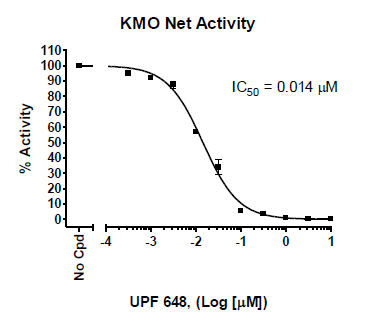KMO Inhibitor Screening Assay Kit
The Kynurenine 3-Monooxygenase (KMO) Inhibitor Screening Assay Kit is designed to measure human KMO enzyme inhibition. The KMO Inhibitor Screening Assay Kit is simple to use. Recombinant human KMO is mixed with the test inhibitor and the reaction is initiated through addition of substrates NADPH and L-Kynurenine. After incubation, KMO activity is determined by measuring the absorption of the reaction product at λ=340 nm. The UV absorption signal correlates with the amount of NADPH remaining in the reaction, therefore the signal is inversely related to the enzymatic activity.
Spectrophotometer capable of measuring absorption of reaction product in the UV range at λ=300-400 nm
96 Reations:
| Catalog # | Name | Amount | Storage | |
| 11307 | KMO, His-FLAG Tag* | 100 µg | -80°C | Avoid multiple freeze/ thaw cycles! |
| 3X KMO Assay Buffer | 20 ml | -20°C | ||
| L-Kynurenine (L-Kyn, 20mM) | 500 µl | -80°C | ||
| NADPH (10 mM) | 500 µl | -80°C | ||
| UV transparent 96-well half area plate | 1 | Room Temp | ||
384 Reactions:
| Catalog # | Name | Amount | Storage | |
| 11307 | KMO, His-FLAG Tag* | 200 µg | -80°C | Avoid multiple freeze/ thaw cycles! |
| 3X KMO Assay Buffer | 20 ml | -20°C | ||
| L-Kynurenine (L-Kyn, 20mM) | 500 µl | -80°C | ||
| NADPH (10 mM) | 500 µl | -80°C | ||
| UV transparent 384-well plate | 1 | Room Temp | ||
*The concentration of the protein is lot-specific and will be indicated on the tube.
Overexpression of IDO1/2 (indoleamine 2,3-dioxygenase) and TDO (tryptophan 2,3-dioxygenase) in tumor cells promotes tryptophan depletion in the microenvironment, resulting in suppression of the T cell-mediated immune response. IDO1/2 and TDO catalyze the breakdown of tryptophan into kynurenine, and KMO plays a key role in that pathway by hydroxylating kynurenine into 3-hydroxykynurenine. KMO is required for the synthesis of quinolinic acid, a neurotoxic NMDA receptor antagonist involved in axonal targeting, synaptogenesis and apoptosis during brain development. KMO activity has been linked to Huntington’s and Alzheimer’s diseases, and research shows that KMO inhibitors can improve the lifespan of mice with Huntington's disease. In addition to being a therapeutic target for neurological disorders, elevated KMO is an indicator of renal and hepatocellular carcinoma, suggesting that KMO may have value as a prognostic biomarker.
Schwarcz, R., and Stone, T.W. 2017. Neuropharmacology. Jan; 112(Pt B): 237–247.
Jin, H., et al. 2015. Sci Rep. 5: 10466.


